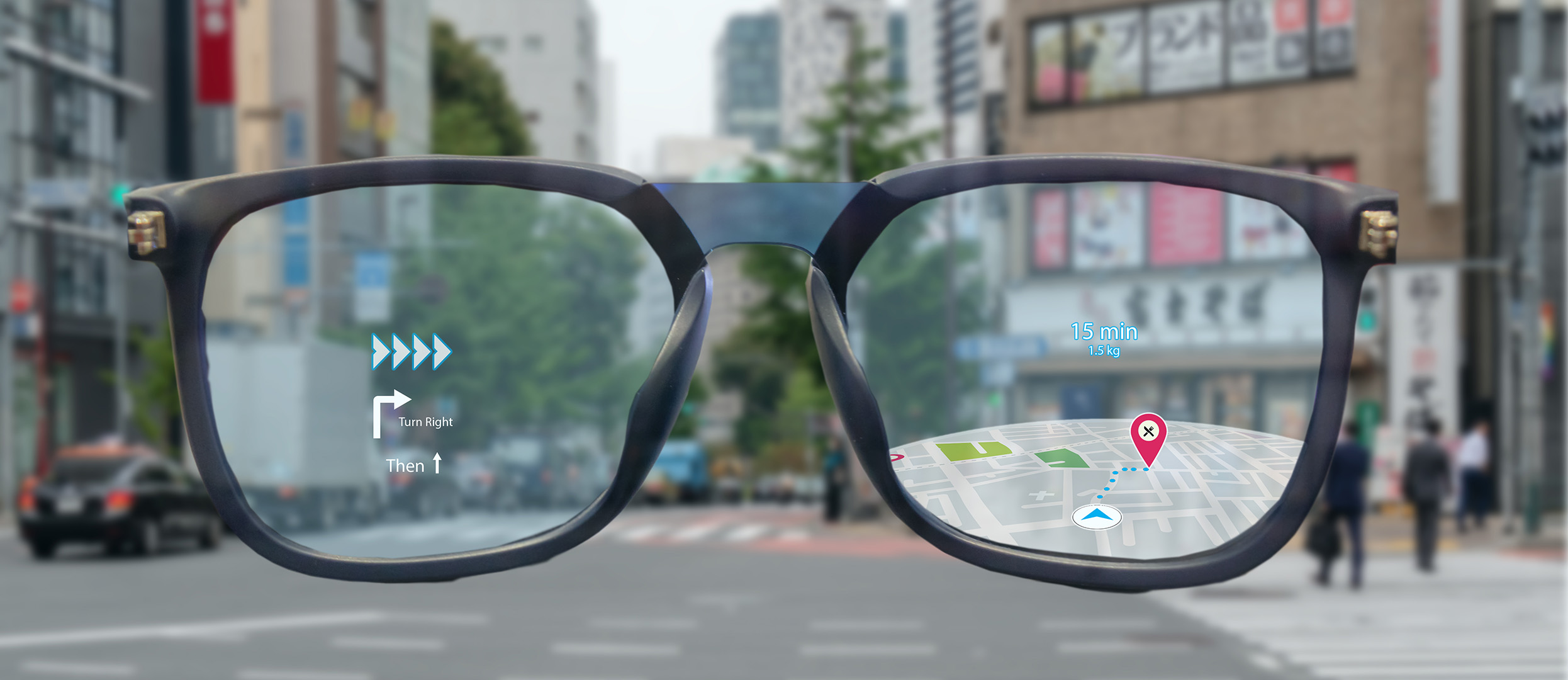
AR Glasses for Consumer & Enterprise Users
Current conversations about AR Glasses seem to diverge down one of two paths. It’s a product for consumers, something to facilitate search, navigation, shopping, and daily personal activity. Or it’s a tool for workplaces, something to execute tasks, analyze data, and guide decision-making. Both use cases bring powerful problem solving to our daily lives.
So, in this light, rather than envisioning a one-size-fits-all device, we can see two distinctly different markets developing for this evolution in spatial computing hardware. Think of it as AR for you, and AR for your work.
We’ve blogged about smartglasses before, but we think all AR hardware deserves ongoing attention. These products have the potential to one day replace our smartphones. So, it’s an exciting time to be watching AR Glasses evolve, bringing the collective vision of so many innovators to fruition.
Smart AR Glasses & Your Phone
The days of clunky, heavy, and just plain awkward prototypes are coming to an end in the world of spatial computing. AR Glasses are no exception. Lenses have taken huge leaps forward – with more on the horizon. And frames are starting to look downright trendy.
Both Apple and Facebook are developing AR Glasses for consumers. The latter is working in partnership with Luxottica (makers of Ray-Ban) to produce a product called Orion. One or both of these products could well be the beginning of a huge shift towards smartglasses completely replacing individual smartphones. We know that’s a big claim, but there are quite a few good reasons we think phone usage has reached its tipping point.
Now is the time, as both consumers and creators, for us to set the bar high and demand AR Glasses that don’t just meet our needs but improve our lives. What do you dislike about your phone? What problems does it fail to solve? What problems does it create?
Top 5 Advantages of Personal Smartglasses
1. Limited Contact
How often do you clean your phone screen or case? The answer should be several times per day. During a pandemic, you’re cleaning even more than that. While most models of AR Glasses have at least one button, designs may also start to incorporate dictation. This could be a product that requires less hands-on (or fingers-on) use.
2. Reduced Distractions
This may be a controversial claim. But glasses have the potential to cut the clutter on our phones. Individual mental health has received a lot of attention in 2020 – which is a really good thing. We believe technology should solve problems, not cause them, so a device that helps make life simpler and performs important tasks without draining our valuable attention spans is an important change.
3. Constrained Socials
Getting rid of social media entirely would be a shame. Being able to stay connected to friends and family, engage with far-flung, yet like-minded professionals – and much, much, more has value. Could switching to a new spatial computing lifestyle cut down on the addictive nature of social channels? Obviously, digital media products themselves need design reviews as well. But perhaps re-learning to engage with spatial computing is an opportunity to re-train our brains around the use of social media.
4. Wearable Convenience
If you’re comfortable wearing a pair of sunglasses, AR Glasses shouldn’t be much of a challenge. While we know glasses can get stepped on or be dropped as easily as a phone can, glasses may be slightly easier to keep from dropping into sinks (or toilet bowls) and falling onto concrete. If they’re comfortable enough to slip on top of your head, smartglasses may be easier to travel with and be forgotten on desks or shelves less often.
5. Productivity Boost
Adding up the benefits above could lead to an increase in time management and personal wellness. We think users of AR Glasses may end up feeling (and actually being) more productive in their personal daily lives. Prioritizing hand cleanliness, breaking addictive habits, and literally seeing the world in a new way will be popular with many people in the coming years.
Using AR Glasses in Enterprise Settings
Most of the individual lifestyle points above (aside from comfort) become moot when we look at an AR or hybrid AR/VR product designed for the workplace. And depending on exactly what work the glasses or headset will perform, it may require proprietary design, taking it further still from the realm of daily-driver personal spatial computing.
We often look at the HoloLens in the context of AR for Enterprise. And in high-tech manufacturing or R&D environments, it’s an excellent choice. But we also expect to see AR Glasses showing up in less heavy-duty workplace settings, including mapping, tourism, and wellness.
Facebook has also created enterprise-level AR Glasses used as a research tool for their recently announced Project Aria. These glasses won’t be for sale to the public, but nevertheless, showcase where the design of workplace smartglasses is headed.
Top 5 Industries Needing Smartglasses
1. Mapping & Navigation
Creation of the AR Cloud is an epic and ongoing project we see as a boom for geologists, cartographers, transport and tourism professionals, and generally anyone involved in creating a digital replica of our planet. The videos above about Project Aria give us ideas about how smart glasses are going to do real-world work in the future.
2. Tech Manufacturing
Whether the AR product looks like the HoloLens mentioned above, or a host of others sure to hit the market in the coming years, we think augmented manufacturing is not just essential, it’s inevitable. From prototyping and testing to training and troubleshooting, AR Glasses can be game-changing. They incorporate Digital Twins to inform adjustments to designs or processes with a mountain of accurate data.
3. Medicine & Wellness
AR brings a wealth of solutions to medical facilities. And using AR/VR in health care is one of our favorite topics, so it’s definitely going to make our list when it comes to using AR Glasses at work. As medical settings need to be more touchless than ever, tools like these can’t get here fast enough. We also love that relaxation AR tools can enhance wellness too, equally important for many people as we adjust to and recover from a year of incredible stress.

Image Credit: metamorworks / Adobe Stock
4. Urban Planning
Civil engineers, urban planners, and any technicians involved in municipal or regional infrastructure are already looking at spatial computing products to solve today’s problems and lay strong foundations for tomorrow. They employ Augmented Analytics and BIM data across buildings and huge structural networks like sewer systems, public transit, and power grids. Possibly the best feature of using a tool like AR Glasses in an urban planning context is the added safety this hardware can offer workers. Being able to analyze broken water main before digging or having an exact location (and condition) of a faulty power line can make the difference between an injury and success by giving technicians as much information as possible upfront.
5. Warehousing & Shipping
Online shopping will only continue to grow as our global economy evolves. As storefronts reduce inventory or close altogether, the need to warehouse consumer goods is going to boom. Managing those facilities properly is going to be critical if e-tailers want to continue shipping as quickly as possible. While parcel volumes for most major carriers remain high, getting orders picked and packed efficiently will be a vital element in any e-tailer’s success. We know warehouses and shipping processes already use spatial computing tools to maintain those high standards. AR Glasses will likely become a growing presence in these settings for e-tailers who want to remain competitive.

Image Credit: zapp2photo / Adobe Stock
Are AR Glasses the right solution for your organization? The answer will always depend on your unique needs and goals. We think they’re worth exploring and luckily this dichotomy of usage scenarios means that you could purchase a personal pair to evaluate the technology. Although you’ll need a commercial, possibly hybrid version for the enterprise use cases above, it could be the stepping stone that gets your business on the augmented path.
Experts in AR Glasses & Spatial Computing
Implementing a fleet of augmented glasses can seem like a monumental task. And it is a big change – but an exciting one! AR Glasses are versatile and powerful, yet they work with and for your employees rather than replacing them.
Whether you’re carefully contemplating that first step or ready to take the plunge and tackle a transformation plan, the Stambol team of spatial computing specialists can help. We are ready to analyze your operations and recommend real-world solutions.
Use our technical expertise and artistic vision to help you adapt and thrive in tomorrow’s world. If you’re considering a technology partner, reach out to our team today with any questions.
Feature Image Credit: Monopoly919 / Adobe Stock


